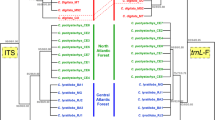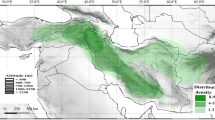Abstract
The existing sectional classification of the genus Crotalaria has merged the Indian sections Calycinae and Crotalaria under the section Calycinae Wight & Arn. emend. M.M.Le Roux & B.-E.van Wyk. Crotalaria subsection Bracteatae is re-evaluated to ascertain its position in the Calycinae clade. Evidences from morphological and molecular sequence data (ITS and trnL-F regions) are used to assess the subsectional position of Bracteatae. Within the recognized 12 species in the subsection, the morphological characters currently used to distinguish these species, are insignificant and overlapping and do not merit diagnostic characters of the species. Examination of the types and vouchers at different herbaria and specimens collected during field trips enabled us for a new interpretation of the existing circumscription of the species. Further, pod anatomical and molecular sequence data were also used for the delimitation of the species. Based on the results of the above studies, a new circumscription has been formalized here and contains five recognized species in the Bracteatae clade, viz., C. berteroana DC., C. longipes Wight & Arn., C. paniculata Willd., C. pulchra DC. and C. pellita DC. of the section Calycinae emend. M.M.Le Roux & B.-E.van Wyk. Crotalaria subsection Bracteatae appeared to be a well supported monophyletic group, but nested within the Calycinae clade. In order to maintain the monophyly of Crotalaria section Calycinae, Bracteatae is synonymized with the former.










Similar content being viewed by others
References
Adema F (2006) Notes on Malaysian Fabaceae (Leguminosae—Papilionoideae) the genus Crotalaria. Blumea 51:309–332
Ansari AA (2008) Crotalaria L. in India. Bishen Singh Mahendra Pal Singh, Dehra Dun, pp 378
Backer CA (1920) Crotalaria valetonii Backer nov. spec. Bull Jard Bot Buitenzorg III 2:324–325
Bisby FA, Polhill RM (1973) The role of taximetrics in angiosperm taxonomy II. Parallel taximetric and orthodox studies in Crotalaria L. New Phytol 72:727–742
Boatwright JS, Le AT, Wink MM, Morozova T, van Wyk BE (2008) Phylogenetic relationships of tribe Crotalarieae (Fabaceae) inferred from DNA sequences and morphology. Syst Bot 33:752–761
Chase MW, de Bruijn AY, Reeves G, Cox AV, Rudall PJ, Johnson MAT, Eguiarte LE (2000) Phylogenetics of Asphodelaceae (Asparagales): an analysis of plastid rbcl and trnL-F DNA sequences. Ann Bot (Oxford) 86:935–956
De Munk WG (1962) Preliminary revisions of some genera of Malaysian Papilionaceae III—a census of the genus Crotalaria. Reinwardtia 6:193–223
Esau K (1962) Anatomy of seed plants. Wiley, New York, pp 316–320
Fahn A (1967) Plant anatomy. Pergamon Press, Oxford, pp 439–449
Fahn A (1982) Plant anatomy, 3rd edn. Pergamon Press, Oxford, pp 457–471
Fahn A, Zohary M (1955) On the pericarpial structure of the legume, its evolution and relation to dehiscence. Phytomorphology 5:99–111
Feder N, O’Brien TP (1968) Plant microtechnique some principles and new methods. Amer J Bot 55:123–142
Flores AS, Correa AM, ForniMartins ER, Azevedo-Tozzi AMG (2006) Chromosome numbers in Brazilian species of Crotalaria (Leguminosae, Papilionoideae) and their taxonomic significance. Bot J Linn Soc 151:271–277
Hijmans RJ (2012) Cross-validation of species distribution models: removing spatial sorting bias and calibration with a null model. Ecology 93:679–688
Hodkinson TR, Chase MW, Takahashi C, Leitch IJ, Bennett MD, Renvoize SA (2002) The use of DNA sequencing (ITS and trnL-F) AFLP and fluorescent in situ hybridisation to study allopolyploid Miscanthus (Poaceae). Amer J Bot 89:279–286
Hopper SD, Fay MF, Rossetto M, Chase MW (1999) A molecular phylogenetic analysis of the bloodroot and kangaroo paw family, Haemodoraceae: Taxonomic, biogeographic and conservation implications. Bot J Linn Soc 131:285–299
Kumar S, Sane PV (2003) Legumes of South Asia—a check list. International Legume Database and Information Service. Roy Bot Gard, Kew, UK, pp 543
Le Roux MM, Van Wyk BE, Boatwright JS, Tilney PM (2011) The systematic significance of morphological and anatomical variation in fruits of Crotalaria and related genera of tribe Crotalarieae (Fabaceae). Bot J Lin Soc 165:84–106
Le Roux MM, Boatwright JS, Van Wyk B-E (2013) A global infrageneric classification system for the genus Crotalaria (Leguminosae) based on molecular and morphological evidence. Taxon 62:957–971
Maddison WP, Maddison DR (2009) Mesquite: A modular system for evolutionary analysis. Version 2.72. http://mesquiteproject.org
Pandey A, Singh R, Sharma KS, Bhandari CD (2010) Diversity assessment of useful Crotalaria species in India for plant genetic resources management. Genet Resources Crop Evol 57:461–470
Pate JS, Kuo J (1981) Anatomical studies of legume pods–a possible tool in taxonomic research. In: Polhill RM, Raven PH (eds) Advances in Legume Systematics. Roy Bot Gard, Kew, pp 903–912
Polhill RM (1968) Miscellaneous notes on African species of Crotalaria L. II. Kew Bull 22:169–348
Polhill RM, Raven PH (eds) (1981) Advances in legume systematics, part 2. Roy Bot Gard Kew, 903–912
Polhill RM (1982) Crotalaria in Africa and Madagascar. Roy Bot Gard, Kew, AA Balkema, Rotterdam, pp 396
Rudd VE (1991) Fabaceae (Leguminosae). Dassayake MD, Fosberg FR A revised handbook to the Flora of Ceylon 7. Balkema, Rotterdam, pp 108–381
Sequencher® version 5.1 sequence analysis software, Gene Codes Corporation, Ann Arbor, MI USA. http://www.genecodes.com
Stamatakis A (2006) RAxML-VI-HPC: maximum likelihood-based phylogenetic analyses with thousands of taxa and mixed models. Bioinformatics 22:2688–2690
Subramaniam S, Pandey AK, Geeta R, Mort ME (2013) Molecular systematics of Indian Crotalaria (Fabaceae) based on analysis of nuclear ribosomal ITS DNA sequences. Pl Syst Evol 299:1089–1106
Taberlet P, Gielly L, Pautou G, Bouvet J (1991) Universal primers for amplification of three noncoding regions of chloroplast DNA. Pl Molec Biol 17:1105–1109
Thompson JD, Gibson TJ, Plewniak F, Jeanmougin F, Higgins DG (1997) The ClustalX windows interface: flexible strategies for multiple sequence alignment aided by quality analyses tools. Nucl Acids Res 25:4876–4882
Van Wyk BE (2005) Tribe Podalyrieae. In: Lewis L, Schrire B, Mackinder B, Lock M (eds) Legumes of the world. Roy Bot Gard, Kew, pp 267–271
Van Wyk BE, Verdoorn GH (1990) Alkaloids as taxonomic characters in the tribe Crotalarieae (Fabaceae). Biochem Syst Ecol 18:503–515
White TM, Bruns T, Lee S, Taylor J (1990) Amplification and direct sequencing of fungal ribosomal RNA for phylogenetics. Academic Press, San Diego, pp 315–321
Acknowledgments
R&D Grant support from University of Delhi to AKP and Senior Research Fellowship from University Grants Commission, New Delhi, to SS are thankfully acknowledged. Thanks are also due to curators of different herbaria for permission to consult specimens. We thank Dr. B. Subramaniam, retired Scientist, Council of Scientific and Industrial Research, India, for accompanying the senior author during plant collection trips. Thanks are due to G-DC herbarium curator for providing with the type images. We are thankful to Dr. Paramjit Singh, Director, Botanical Survey of India for permission to consult herbaria.
Author information
Authors and Affiliations
Corresponding author
Additional information
Handling editor: Hiroshi Tobe.
Electronic supplementary material
Below is the link to the electronic supplementary material.
Rights and permissions
About this article
Cite this article
Subramaniam, S., Pandey, A.K. & Rather, S.A. A revised circumscription of the species in Bracteatae complex (section Calycinae) in the genus Crotalaria L.: evidence from nuclear and chloroplast markers. Plant Syst Evol 301, 2261–2290 (2015). https://doi.org/10.1007/s00606-015-1228-8
Received:
Accepted:
Published:
Issue Date:
DOI: https://doi.org/10.1007/s00606-015-1228-8




